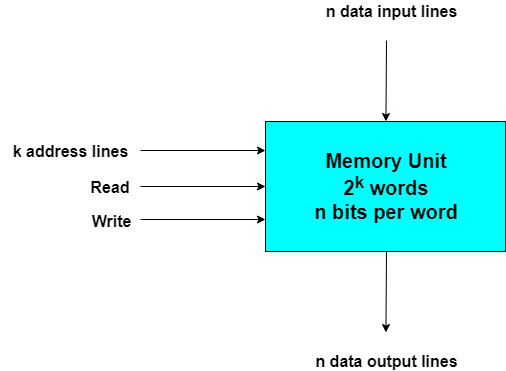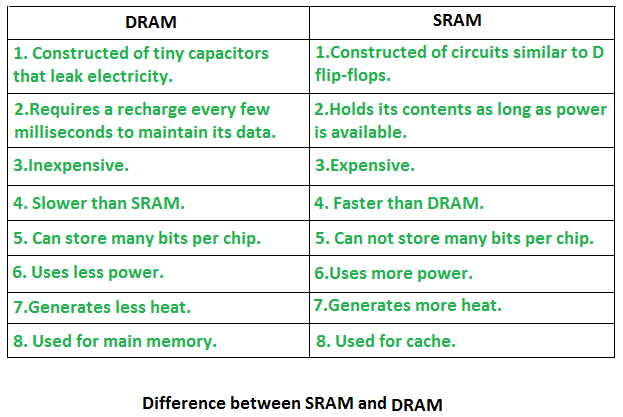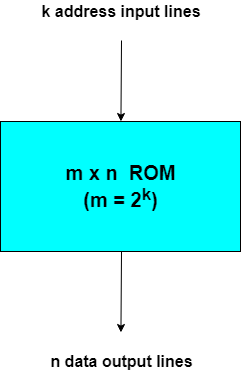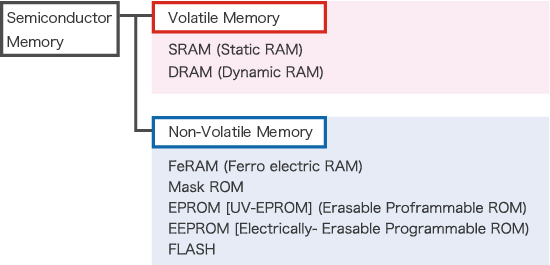Semiconductor Memories
Unit 8 (DE & Mic. processor)
What is Semiconductor Memory?
Semiconductor memory is a type of semiconductor device tasked with storing data.
There are two electronic data storage mediums that we can utilize, magnetic or optical.
There are two electronic data storage mediums that we can utilize, magnetic or optical.
Magnetic storage:
- Stores data in magnetic form.
- Affected by magnetic fields.
- Has high storage capacity.
- Doesn't use a laser to read/write data.
- Magnetic storage devices are; Hard disk , Floppy disk, Magnetic tape etc.
Optical storage:
- Stores data optically, uses laser to read/write.
- Not affected by magnetic fields.
- Has less storage than a hard disk.
- Data accessing is high, compared to a floppy disc.
- Optical storage devices are; CD-ROM,CD-R, CD-RW, DVD etc.
There is also volatile memory. This is memory that loses its data once power is cut off, while non-volatile memory retains data even without power.
Semiconductor Memory Types
Memory
- A memory is a semiconductor of magnetic device used for storage of digital data.
- A memory location is a group of storage devices that will hold one data word.
- A data word length of 8-bits is called a byte.
- Each memory location can store a different data word and has a unique address.
- Memory can hold one or more bits of information to store the Data, Instruction, and Addresses.
- Memory can be classified into the following three groups.
Memory Unit
A Memory Unit is a collection of storage cells together with associated circuits needed to transfer information in and out of storage.
Word
The memory stores binary information(1's and 0's) in groups of bits called words. A word in memory is an entity of bits that move in and out of storage as a unit. A memory word is a group of 1's and 0's and may represent a number, an instruction code, one or more alphanumeric characters, or any other binary coded information.
Byte
A group of eight bits is called a byte. Most computer memories use words whose number of bits is a multiple of 8. Thus a 16-bit word contains two bytes, and a 32-bit word is made up of 4 bytes.
Register Memory
Register memory is the smallest and fastest memory in a computer. It is not a part of the main memory and is located in the CPU in the form of registers, which are the smallest data holding elements. A register temporarily holds frequently used data, instructions, and memory address that are to be used by CPU. They hold instructions that are currently processed by the CPU. All data is required to pass through registers before it can be processed. So, they are used by CPU to process the data entered by the users.
Random Access Memory (RAM) and Read Only Memory (ROM)
Memory is the most essential element of a computing system because without it computer can’t perform simple tasks. Computer memory is of two basic type – Primary memory(RAM and ROM) and Secondary memory(hard drive,CD,etc.). Random Access Memory (RAM) is primary-volatile memory and Read Only Memory (ROM) is primary-non-volatile memory.

1. Random Access Memory (RAM) –
- It is also called as read write memory or the main memory or the primary memory.
- The programs and data that the CPU requires during execution of a program are stored in this memory.
- It is a volatile memory as the data loses when the power is turned off.
- RAM is further classified into two types- SRAM (Static Random Access Memory) and DRAM (Dynamic Random Access Memory).
RAM is a volatile memory, which means it does not store data or instructions permanently. When you switch on the computer the data and instructions from the hard disk are stored in the RAM, e.g., when the computer is rebooted, and when you open a program, the operating system (OS), and the program are loaded into RAM, generally from an HDD or SSD.

Types of RAM:
Integrated RAM chips can be of two types:
- Static RAM (SRAM):
- Dynamic RAM (DRAM):
1) Static RAM:
The SRAM memories consist of circuits capable of retaining the stored information as long as the power is applied. That means this type of memory requires constant power. SRAM memories are used to build Cache Memory.
Static RAM (SRAM) is a type of random access memory that retains its state for data bits or holds data as long as it receives the power. It is made up of memory cells and is called a static RAM as it does not need to be refreshed on a regular basis because it does not need the power to prevent leakage, unlike dynamic RAM. So, it is faster than DRAM.
2) Dynamic RAM:
DRAM stores the binary information in the form of electric charges that applied to capacitors. The stored information on the capacitors tend to lose over a period of time and thus the capacitors must be periodically recharged to retain their usage. The main memory is generally made up of DRAM chips.
Dynamic Ram (DRAM) is also made up of memory cells. It is an integrated circuit (IC) made of millions of transistors and capacitors which are extremely small in size and each transistor is lined up with a capacitor to create a very compact memory cell so that millions of them can fit on a single memory chip. So, a memory cell of a DRAM has one transistor and one capacitor and each cell represents or stores a single bit of data in its capacitor within an integrated circuit.
The capacitor holds this bit of information or data, either as 0 or as 1. The transistor, which is also present in the cell, acts as a switch that allows the electric circuit on the memory chip to read the capacitor and change its state.

Read Only Memory (ROM) –
- Stores crucial information essential to operate the system, like the program essential to boot the computer.
- It is not volatile.
- Always retains its data.
- Used in embedded systems or where the programming needs no change.
- Used in calculators and peripheral devices.
- ROM is further classified into 4 types- ROM, PROM, EPROM, and EEPROM.

T
Types of Read Only Memory (ROM) –
- PROM (Programmable read-only memory) – It can be programmed by user. Once programmed, the data and instructions in it cannot be changed.
- EPROM (Erasable Programmable read only memory) – It can be reprogrammed. To erase data from it, expose it to ultra violet light. To reprogram it, erase all the previous data.
- EEPROM (Electrically erasable programmable read only memory) – The data can be erased by applying electric field, no need of ultra violet light. We can erase only portions of the chip




No comments:
Post a Comment